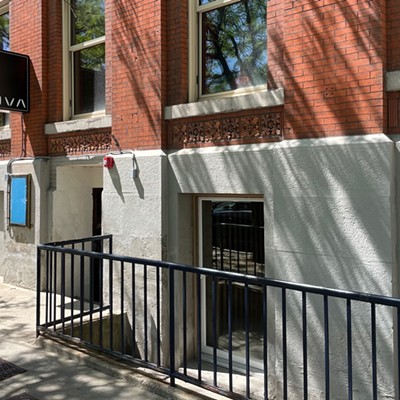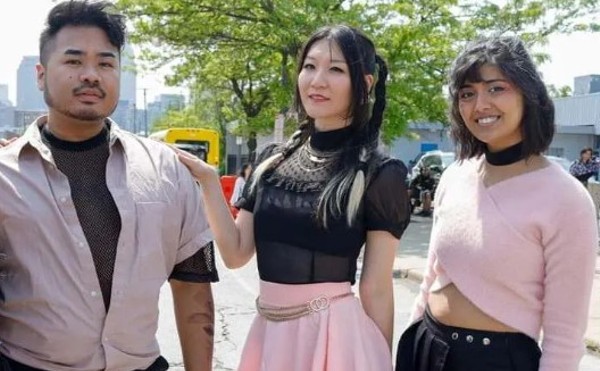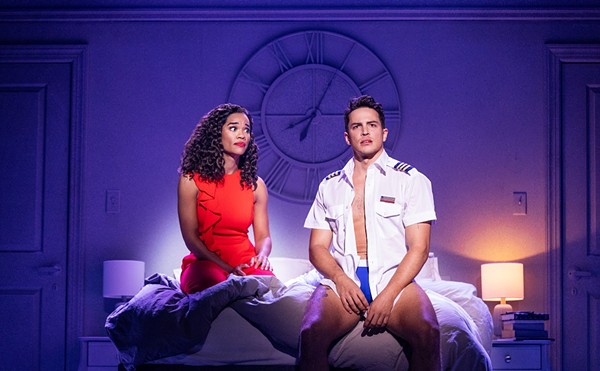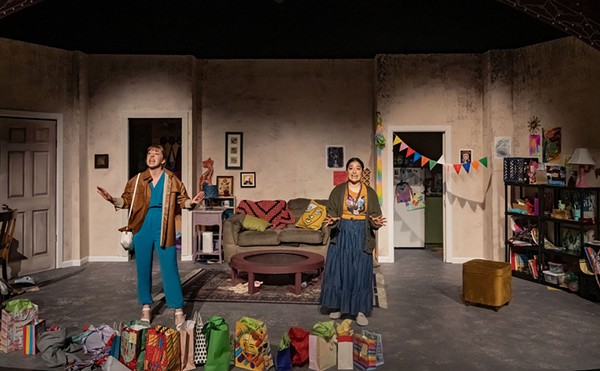
Misha Kligman: Icons for the Nonbelievers -- Whether he sells one or every picture on display, 2001 Cleveland State graduate Misha Kligman should count his first solo exhibition a success. His oil paintings are derived by stripping fashion magazine covers of their ink and overlaying them with entirely different colors; the results are shadowy portraits that would be appropriate in a cathedral, if only the figures were biblical. In "April," one of only two titled works, a bird stands on the shoulder of a girl with slick hair pulled back over a face as white as a mime's. The pictures look like relics of a bygone era, oddly tinted daguerreotypes of people who, as models, had perfect skin, hair, and bone structure, but never quite existed among the living. Their skin now appears far too sallow to be traditionally beautiful, their haunting oval eyes -- one of few traits that remains recognizably human -- burn through the layers in ways both alluring and frightening. Meanwhile, Kligman's dark tones render their glamorous poses silly and their once-lavish costumes as coarse rags. This show marks a strong start for an artist worth knowing better. Through March 26 at the E. Gordon Gallery, 2026 Murray Hill Road, 216-795-0971. -- Zachary Lewis
59th Student Independent Exhibition 2005 -- Humor and seriousness vie for dominance in this sizable exhibition, organized by students at the Cleveland Institute of Art. For humor, it's hard to beat Beth Whalley's juxtaposition of dainty and industrial in "Drill Cozy," or the outrageous oddity of Wes Friedrich's "Honey I'm a Ninja," a picture of a husband confessing to his shocked wife; there's also a historically stylized oil portrait of Eric Cartman, the foul-mouthed kid from South Park, by David Torowski. Among the more contemplative works: Angela Oster's metaphorically potent "Secrets," a picture of six black gloves connected by a web; Colleen McCullen's impossibly narrow-waisted and busty Girl Scout dress; and Carol Traymor's faux dead deer, made of fabric from hunting clothes. Amid the funny and serious works are plenty of less effective pieces, as well as those that defy categorization: Cecilia Philips' picture of a dark-haired woman standing on a craggy, windswept cliff, for instance, is simply beautiful, and it's not without peer in this quirky and largely worthwhile gathering of contemporary art. Through March 13 at The Cleveland Institute of Art, 11141 East Boulevard, 216-421-7407. -- Lewis
ONGOING
From Leipzig -- The seven young artists here are all representational painters associated with the Leipzig Academy of Visual Arts, yet there is tremendous variety among the show's seven paintings, covering a wide palette of styles and subjects. Martin Kobe and David Schnell are fascinated with perspective: In Schnell's acrylic, "Stangen im Mai," a grid thickly populated with trees and other vertical objects extends beyond sight in every direction; Kobe's untitled acrylic resembles a surrealistic architectural design, in which the walls, floors, furniture, and blank space have been dipped in red and stretched to infinity. A surrealism more versed in the tradition of Magritte reigns in "Automat," Matthias Weischer's four-panel oil on canvas: Here, a peculiar object -- a cross between a bed and a pinball machine -- stands like a shrine inside a ruined open-air temple that no one ever visits. It's strange and compelling in its odd stillness. German political and industrial history is the subject of "Prozession," the oil-on-paper narrative-style painting by Neo Rauch, who at 44 is the oldest artist in the show. An atmosphere of decay pervades the unusual composition: Giant men in top hats hold small men in their hands like slaves, while others trudge into a factory that's billowing smoke into an already darkened sky; the impression is of a bleak labor sector in which the workers hold little power. With only one work from each artist and all displayed in a single gallery, From Leipzig whets the appetite for more from each. Through May 1 at the Cleveland Museum of Art, 11150 East Blvd., 216-421-7340. -- Lewis
Luc Delahaye Photographs: History -- French photographer Luc Delahaye's 4-foot-by-8-foot images are narratives -- sometimes direct, sometimes subtle -- of world events. "Taliban," from 2001, shows the corpse of a man crumpled on a dusty road. His clothing blends with the rocks and fallen leaves around him; the only contrast of colors within the image is the brilliant red slash across his neck. "The Milosevic Trial," from 2002, is deceptively plain. Without the title, the image might be mistaken for any ordinary government conference room. Delahaye's compositions are often beautiful, even when the subject matter is disturbing. Their large size and wide views make them particularly effective. On view through February 23 at the Cleveland Museum of Art, 11150 East Blvd., 216-421-7340, www.clevelandart.org. -- Tami Miller
Magic/Mystery: Recent Paintings by Patrick Kelly -- Patrick Kelly's new works are not action paintings in the expressionist sense, but a sense of movement does pervade them. The Cleveland-based artist doesn't drip latex à la Pollock, but his dark, somber oil paintings and mixed-media wall hangings resonate with spiritual life by suggesting vast cosmic processes and leading the eye on complex visual journeys. The neatly crisscrossing bands on a duskily shaded linen painting called "Flipside" are so geometrically perfect, they could be instructions for mentally folding the rectangular surface into a triangle. Lines radiate from the swirling center of "Fractured Core," evoking a gaseous explosion in space. Perhaps the best example of Kelly's idea of motion can be found in a complementary pair of works: The wall hanging "Tracing," with its cluster of thin white slats bent into a sinuous wave pattern, calls to mind graphs of mathematical equations in a work of elegant beauty; a linear motif reappears in the painting "Walk the Line," only the pattern is far messier and the colors hover in the territory of earthy browns, blacks, and yellows. An attempt to literally walk the line (actually line fragments) would be futile, but it's hard to resist imagining it anyway. Through February 26 at the Bonfoey Gallery, 1710 Euclid Ave., 216-621-0178. -- Lewis
Natalie Roelle -- Co-owner of Cleveland's Voodoo Monkey tattoo parlor, Natalie Roelle spends most of her days painting on skin. That influence is clear in her work at Bela Dubby, a new retro-style internet café and bar in eastern Lakewood. The eight acrylic paintings reveal Roelle expanding her palette and musing with greater freedom, in larger dimensions. Each adheres closely to the playful tattoo aesthetic, reveling in bright colors and enigmatic subject matter that borders on the surreal. Roelle paints androgynous human figures that are thin and lithely muscular, with sharply chiseled features and big eyes -- almost like robots. Many wear strange hats, crowns, or masks, or are endowed with animal traits; one feminine figure is crouching tightly while holding a rabbit or dog mask over her face. At the center of another painting is a huge, lavishly ornate sword; psychedelic swirls and paisley patterns serve as background or embellishment to the central image. A strong imagination is clearly behind each painting, and it's easy to imagine any of them as a tattoo on a giant's arm or back. What, if anything, they mean, though, must be decided during a long conversation over beer or coffee. Through February 28 at Bela Dubby, 13321 Madison Avenue, Lakewood, 216-221-4479. -- Lewis
Psychological Expressionism: The Art of Sid Rheuban -- A Cleveland native and retired bond salesman, octogenarian Sid Rheuban has been painting for less than 15 years, yet his work is at a master's level. The title of this large retrospective is right on the money: The emotional lives of the figures he paints -- elderly men, teenagers, variously occupied older women, and a few sardonic self-portraits -- resound across his canvases. Rheuban derives meaning from a wide range of exaggerated physical characteristics, but it's his subjects' eyes, painted disproportionately large and darkly outlined, that often become their most expressive feature. True to the definition of expressionism, the colorful and flat but rather bleak world Rheuban paints around his figures is more an extension of their interior climates than a simple background. Canvas, though, is not necessarily Rheuban's preferred surface; some of his most imaginative work takes place on Plexiglas, which endows the paintings with a lifelike three-dimensional quality and additional warmth. A number of these are suspended mid-gallery from the ceiling, allowing viewers to examine both sides. One, "Prussian Blue," depicts a woman with large, knotted hands. Her outline appears black, until one looks through the paint. Similarly, Rheuban seems to have peered directly into the true nature of each of his subjects, with affection, honesty, humor, and understanding. Through March 11 at the Cleveland State University Art Gallery, 2307 Chester Ave., 216-687-2103, www.csuohio.edu/art/gallery/main.htm. -- Lewis
Sean Derry: The Soundings of a Weightless Line -- This tranquil, site-specific installation re-creates Derry's questionably scientific but deeply poetic attempt to "hear" the clouds. It consists of the wondrous, Jules Verne-like contraption Derry used in his experiment. Here's the blueprint: Long strands of wire connect two speakers, one of which is attached to a clear plastic box that collected moisture, the other to a plastic box amplifying the faint crackling sounds recorded in the sky -- the true voice of the clouds. At the same node, Derry's voice can be heard reciting the alphabet. Perhaps he's reminding us of the childlike spirit behind the work. The whole structure is suspended by large red balloons filled with helium, which are bound to sag over the course of the exhibit; even a slight touch causes the structure to wobble powerfully, producing a strange low rumbling. A dirty, shredded fragment of balloon at the entrance points to the trial-and-error process Derry must have followed. Some balloons extend beyond sight above the drop-tile ceiling through panels of tinted glass. These simulate the effect of looking up at the sky and, brilliantly, prompt the viewer into wondering what's up there. Better still, Derry turns the viewer into a passenger on a dream-like ride into the clouds, where the only sound is the occasional drip or crackle and the world's troubles lie safely far below. Through March 4 at the Sculpture Center, 1834 E. 123rd St., 216-229-6527. -- Lewis
Stray Shopping Cart Project: Cleveland and Environs -- Julian Montague's one-room installation is admirable for the painstaking effort that went into creating a project of such mammoth, overblown inconsequence. Even more than that, it's laughable. The Buffalo artist has catalogued with absurd precision the various species of forgotten grocery carts that populate the city. Like a sociologist, Montague scoured Cleveland's parking lots looking for poor, neglected carts left out in the cold and documented their descent: from abandonment next to our cars to their near-decomposition or complete transformation. (One especially mangled example inhabits the center of the room.) Most of the display, however, consists of ludicrously complicated flow charts laden with photographs and tiny labels, detailed maps that look like instructional diagrams for a military takeover, and far, far too much text. Each cart is a "specimen," whose unfortunate situation merits thorough examination. Found objects have long been fodder for art, and here Montague takes the practice to the extreme. But beyond the humor and jargon, it's not hard to hear the artist's condemnation of our distracted, materialistic, disposable society. Then again, it's possible that he made up part or all of it, and a deeper meaning simply isn't there. Maybe the joke's on us, for looking. Through March 11 at Spaces, 2220 Superior Viaduct, 216-621-2314. -- Lewis
Topographic -- Explanation for this show's title lies in a statement accompanying a wall drawing by Mark Taylor. "Wild Wonderful," which happens to resemble a gigantic topographic map, consists of "multiple images . . . meant to activate remembered or imagined scenarios." That it certainly does. The statement also applies rather well to the work of the other 10 artists in the show, whose installations and multimedia projects comment -- with varying degrees of success -- on the developed world. Two constructions by Chicago artist Yoshiko Kanai are the most profound items here: Her "Sea of the People" is a small pond inhabited by real goldfish and lined on either side by towers that look like sand castles. Three-dimensional human faces emerge from the water, forming a kind of stepping-stone path from one side to the other. It's a beautiful realization of the notion that only people can heal mankind's divisions. Kanai carries the point further in a similar piece, in which water from the pond drips onto a slowly dissolving landscape made of sugar and dotted with tiny tanks and airplanes. Elsewhere, Neil McDonald's deliberately blurred paintings of sites where planes have crashed transform scenes of tragedy and catastrophic malfunction into strangely pleasant abstract landscapes; also memorable are Mark Slankard's photos of flimsy, barren, cookie-cutter suburban homes under the heading "Curb Appeal." Through March 11 at Spaces, 2220 Superior Viaduct, 216-621-2314. -- Lewis
Visions of Japan: Prints and Paintings From Cleveland Collections -- The Cleveland Museum of Art has accrued an immense stock of Japanese prints, but it has never before mounted a show like "Visions of Japan," which spans the 18th century to modern times. The exhibit runs along a hallway, forming a sort of three-dimensional timeline. At one end is a wealth of early color paintings and woodcuts in the Ukiyo-e tradition: painstakingly detailed and varied landscapes of Mount Fuji, as well as crowd scenes from the city's geisha district and portraits featuring Kabuki actors. Major artists with recognizable styles are represented here, including Hokusai and Hiroshige. Modern Japanese artists reinvigorated the print tradition, using the craft in countless new ways and blending it with Western styles and techniques. Their work forms the show's second and perhaps more impressive half. With so much to see in this section, a few brief highlights must suffice: "Washing Hair," an ink-on-silk drawing of jaw-dropping beauty by Torii Kotondo; a tiny but surprisingly potent mezzotint called "Ball of Yarn" by Yozo Hamaguchi; and Kiyoshi Saito's masterful adaptation of natural wood grain into a picture. A minimalist abstract by Shoichi Ida, in which two ink-blots have soaked from opposite sides into a delicate sheet of paper, may be the most poetic and densely Japanese vision of them all. Through February 20 at the Cleveland Museum of Art, 11150 East Blvd., Cleveland, 216-421-7340, www.clevelandart.org -- Lewis











